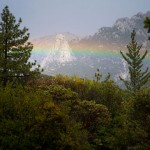
The absence of a local lake has helped shape Idyllwild’s lasting character, a fact for which many Hill residents are grateful. But as with skiing, this omission from our recreational menu has not always been overlooked.
When Claudius Lee Emerson bought the Idyllwild Inn in 1917, he soon cast his eye on a recreational lake site midway down the valley. (There’s a reason Lake Lane intersects Tollgate Road.)
Throughout the 1920s, he promised a lake to potential buyers and steadily became more publicly assertive about his intent to dam Strawberry Creek, even announcing imminent construction in 1927. His 1928 marketing brochure depicted “Idyllwild Waters” on a detailed map, and that summer word spread off the Hill that lakefront lots were selling like hotcakes.
But alas for Emerson, the 1929 Wall Street crash doomed any further development, and his dream died once and for all. The lake site’s future became residential housing, summer camps, and a mobile home park.
Emerson was not alone in his quest for watery fun. By 1939, the Riverside County Chamber of Commerce convinced the board of supervisors of a need for more recreational lakes. The board assigned County Surveyor A.C. Fulmor to survey potential sites for constructing small ones that could offer seasonal swimming, boating, and ice-skating for mountain visitors.
The only tangible result today is Lake Fulmor, created by damming Indian Creek to Highway 243 across Hall Canyon. Spring runoff first filled the lake in 1948, and opening day of the 1950 season drew the largest turnout of fishermen in mountain history.
Recreation isn’t the only reason people create lakes. Electrical power generation is another. Indeed, a flurry of rumors in the early 1910s attracted a federal investigation into possibly illegal water filings on our western slopes. But the rumors proved groundless, and power companies stayed away.
The other main reason to create a lake is water storage to stabilize supplies for agricultural and domestic use. Our oldest and best known example is Lake Hemet in Garner Valley, which was created in 1895 by Hemet Dam.
In 1933, after futilely trying to keep people and boats out of the water, the Lake Hemet Water Company gave in, clearing the way for boating, fishing, and today’s campground with its resident population of RV dwellers.
Another such storage reservoir is Foster Lake, which was dug out of Dutch Flat in 1946 to collect water from Strawberry Creek (pumped from town to the lake) and let it percolate into nearby distribution wells. Boating and fishing were allowed at first, but today the lake is off-limits to the public.
Artificial lakes, of course, only imitate nature. The granddaddy of all San Jacinto Mountain lakes, now quite feeble in its old age, sits far away from Idyllwild, oddly perched atop an 8,800-foot-high ridge in the state park wilderness. Originally called Lake Surprise by its 1880 discoverer, George Hannahs, it became known as Hidden Lake by 1907.
The Palm Springs Aerial Tramway dramatically eased access to Hidden Lake in 1963. By 2002, so many horses and humans had tromped through its shallow waters and trampled its shoreline, a unique habitat was threatened with being loved to death. The state park set the area aside as a nature preserve to give it a chance to recover, and, at least for now, the lake is unfortunately no longer accessible.
Sadly, the instinctive human affinity for water still trumps our ability to say “no” to a basic urge, even when the result becomes destructive. It’s just as well the temptation to create another lake has been foiled here in Strawberry Valley.










